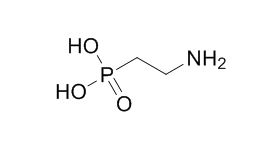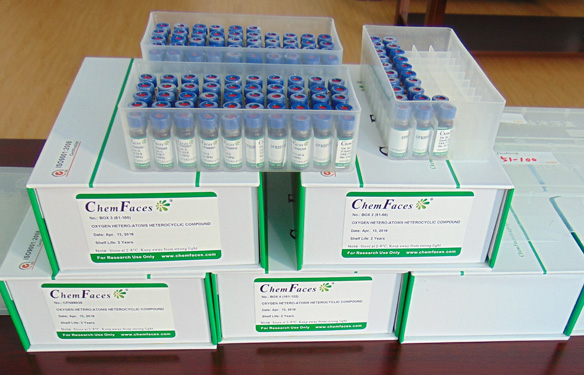(2-Aminoethyl)phosphonic acid
2-Aminoethylphosphonic acid as an indicator of Tetrahymena pyriformis W growth in protein-quality evaluation assay.
Inquire / Order:
manager@chemfaces.com
Technical Inquiries:
service@chemfaces.com
Tel:
+86-27-84237783
Fax:
+86-27-84254680
Address:
1 Building, No. 83, CheCheng Rd., Wuhan Economic and Technological Development Zone, Wuhan, Hubei 430056, PRC
Providing storage is as stated on the product vial and the vial is kept tightly sealed, the product can be stored for up to
24 months(2-8C).
Wherever possible, you should prepare and use solutions on the same day. However, if you need to make up stock solutions in advance, we recommend that you store the solution as aliquots in tightly sealed vials at -20C. Generally, these will be useable for up to two weeks. Before use, and prior to opening the vial we recommend that you allow your product to equilibrate to room temperature for at least 1 hour.
Need more advice on solubility, usage and handling? Please email to: service@chemfaces.com
The packaging of the product may have turned upside down during transportation, resulting in the natural compounds adhering to the neck or cap of the vial. take the vial out of its packaging and gently shake to let the compounds fall to the bottom of the vial. for liquid products, centrifuge at 200-500 RPM to gather the liquid at the bottom of the vial. try to avoid loss or contamination during handling.
FARMACIA2023, Vol.71,3.
Biomed Pharmacother.2024, 179:117365.
Eur J Pharmacol.2023, 960:176121.
Kaohsiung J Med Sci.2023, 10.1002/kjm2.12764
Phytochemistry.2024, 222:114102.
Appl. Sci.2023, 13(17), 9653.
Molecules.2019, 24(16):E2985
Chemical Engineering Journal2024, 500:157110
Sci Rep.2023, 13(1):13610.
Sci Rep.2019, 9(1):18080
Related and Featured Products
J Biomed Mater Res A. 2010 Oct;95(1):58-67.
A new amido phosphonate derivative of carboxymethylcellulose with an osteogenic activity and which is capable of interacting with any Ti surface.[Pubmed:
20740601 ]
A new phosphonate derivative of carboxymethylcellulose (CMC) was recently synthesized (CMCAPh).
METHODS AND RESULTS:
The phosphonate polysaccharide was obtained by using a carbodiimide-like activating agent for carboxylic groups and 2-aminoethyl-phosphonic acid to create an amide bond between the amine of the phosphonate agent and the carboxylic acids of CMC. The polymer was characterized by (31)P NMR, FT-IR, and potentiometric titration. CMCAPh showed different properties from CMC and its amidated derivative polymer CMCA. The behavior in solution of CMCAPh polymer towards normal human osteoblasts (NHOst) was studied in vitro, monitoring the cell proliferation, cell differentiation, and osteogenic activity and was then compared with the amidic derivative of carboxymethylcellulose (CMCA). Furthermore, CMCAPh was used to coat titania disks with the aim of increasing the osteogenic activity of implant surfaces.
CONCLUSIONS:
The polymer film on the titania surface was characterized by AFM and TOF-SIMS analysis. An ATR FT-IR study was carried out to evaluate the polymer bonding mode onto the titanium surface. Osteoblast morphology was evaluated by SEM. Adhesion analysis of NHOst demonstrated a better adhesion on the titanium surface coated with CMCAPh than on the bare titanium surface..
Br J Nutr. 1978 Jul;40(1):83-90.
(2-Aminoethyl)phosphonic acid as an indicator of Tetrahymena pyriformis W growth in protein-quality evaluation assay.[Pubmed:
96851]
1. The concentration of (2-Aminoethyl)phosphonic acid(AEP) in 96 h cultures of Tetrahymena pyriformis W was studied in order to apply it as an indicator in the assay of the relative nutritive value (RNV; protozoa population with test protein:protozoa population with whole-egg powder) of protein.
METHODS AND RESULTS:
Foodstuffs and food mixtures of different protein contents and qualities were used as test samples. 2. RNV values based on AEP determination (RNVAEP) were compared with corresponding values calculated from protozoa counts (RNVpc), as well as with biological value (BV) and net protein utilization (NPU) of the same proteins assayed on rats. 3. Both for foodstuffs and food mixtures highly significant correlations were found between RNVAEP and RNVpc, RNVAEP and both BV and NPU, and RNVpc and both BV and NPU.
CONCLUSIONS:
4. AEP content in the protozoal suspension was preferred to cell count as a measure of growth response, since it took into account large differences in cell dimensions that were observed between cultures grown with different test proteins.
Biotechnol Prog. 2007 Nov-Dec;23(6):1425-30.
Protein binding to amphoteric polymer brushes grafted onto a porous hollow-fiber membrane.[Pubmed:
17918859]
METHODS AND RESULTS:
Three kinds of ampholites, i.e., 3-aminopropionic acid (NH2C2H4COOH), (2-Aminoethyl)phosphonic acid (NH2C2H4PO3H2), and 2-aminoethane-1-sulfonic acid (NH2C2H4SO3H), were introduced into an epoxy group-containing polymer brush grafted onto a porous hollow-fiber membrane with a porosity of 70% and pore size of 0.36 microm. Multilayer binding of the protein to the amphoteric polymer brush, with a degree of multilayer binding of 3.3, 8.6, and 15 for Lf, Cyt c, and Ly, respectively, with the (2-Aminoethyl)phosphonic acid-immobilized porous hollow-fiber membrane, was demonstrated with a negligible diffusional mass-transfer resistance of the protein to the ampholite immobilized.



